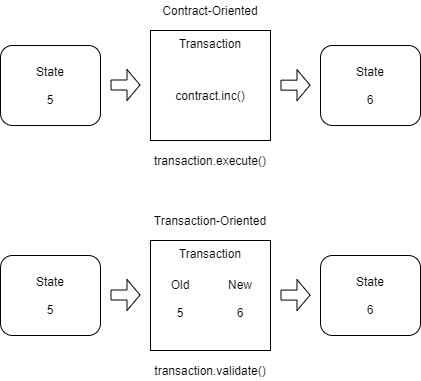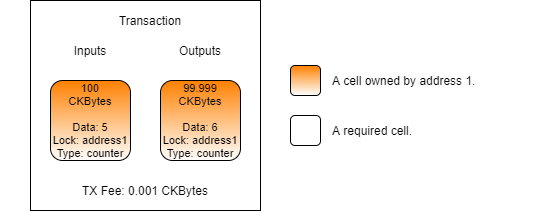Introduction to Scripting Part 1
Nervos uses small programs known as "scripts" to provide on-chain programmability. This is how Nervos achieves smart contract functionality that is similar to other blockchain platforms. However, Nervos' approach is significantly different than most other platforms.
Nervos is based on the Cell Model, which we first introduced earlier. This is significantly different than the Account Model, which is used by most other platforms, including Ethererum. Both models can be used to create the same type of functionality, and build many of the same applications, but the approach that must be taken is conceptually very different.
Account Model vs. Cell Model
Ethereum uses the Account Model, which is similar to having an account at the bank. Your account has a single number that represents your balance. You can also have balances for other tokens. Every balance amounts to a single number that is attached to an account and every account is a representation of a user's public key or an on-chain smart contract. Every action that occurs on the blockchain can be described in a simplified way as a change to a balance on an account.
Nervos uses the Cell Model, which cannot be compared to an account at the bank. It's more like having multiple smaller sums of money stored in multiple different safes. Each safe might have a different amount of money, and there isn't a single number that represents the total amount you have. Your total balance is the total amount of value that is stored in all the safes (known as cells). Every cell has an owner, that could be linked to a user's public key or an on-chain script. Every action that occurs on the blockchain can be described in a simplified way as a change to the balance of a cell.
Contract Oriented vs. Transaction Oriented
Ethereum's programming model is sometimes described as being part of a contract-oriented paradigm. The developer builds programs, known as contracts, which dictate how on-chain state changes occur. Methods on the contract are used to control state changes. An example would be the transfer() method of an ERC20 token contract. This method is used to send tokens from one account to another. A developer initiates a state change by creating a transaction that includes the method to call and supplies the necessary arguments to the method.
Nervos' programming model is transaction-oriented. There are no methods on a contract to call. The developer builds programs, known as scripts, which validate how an on-chain state change is allowed to occur. A developer initiates a state change by submitting a transaction that describes a valid state change.
This image shows how a basic counter would be implemented on a contract-oriented model vs. a transaction-oriented model. In both models, the counter can be increased by exactly 1 per transaction. In the contract-oriented model, a transaction contains an execution call to the contract's inc() method which is used to increase the value of the state by 1. This call is executed on-chain to change the state.
In the transaction-oriented model, the transaction contains both the old state and the new state that we want to change it to. There is no method call. The transaction is validated on-chain by executing the appropriate scripts. If the validation is successful, the on-chain state is updated.
In the example image, we don't use cells or talk about inputs and outputs. This is because we are describing the process at a high conceptual level so it can be more easily compared. On Nervos, the transaction would look more like this.
The transaction fully describes the end result, even before the transaction has been broadcasted to the network. In the left cell, you see a data value of 5. This is the state that currently exists on the blockchain. On the right is the new cell, with an increased value of 6. You could put whatever value you want in the right cell, but only a transaction with a value of 6 would confirm. This is because the details of the transaction are being validated by scripts. The scripts being used are indicated by the Lock and Type fields on a cell, which are short for Lock Script and Type Script. We will explain more about these in the next lesson.
If this seems confusing or counter-intuitive, don't be discouraged. This is a brand new way of creating smart contracts, so it may be difficult to understand at first. It will become clear as we continue to work with it.
Generation vs. Validation
Any transaction on Nervos undergoes both generation and validation. A transaction describes a state change and is generated off-chain. When the transaction is broadcast to the network, it is validated on-chain by the lock scripts and type scripts.
Let's look at the counter transaction one last time.
This transaction would be generated off-chain. This could be done in several languages, but Javascript and Typescript are the most common. The transaction describes what should happen by indicating the current state (inputs) and the desired resulting state (outputs).
Once it is broadcasted to the network, the lock scripts and type scripts attached to the cells in the transaction will execute and validate the transaction.
Let's describe it another way by looking at the contract-oriented vs transaction-oriented image again.
In the contract-oriented version, the generator creates a transaction that describes what on-chain method should be called to update the state. It creates a transaction which indicates that the contract.inc() method should be called. When the transaction is executed on-chain, it calls the contract.inc() method to change the state. This method will retrieve the current state value, increase it by 1, then update the state.
In the transaction-oriented version, that same logic is still used, but it distributed differently between the off-chain and on-chain components. The off-chain generator calls the contract.inc() method which will retrieve the current state value, and increase it by 1. But it can't save it directly since this is executing off-chain. To save the new state value, it must form a transaction that describes the state change, then broadcast it to the network. The on-chain scripts then validate that the indicated change is valid, then update the state.
This approach is less intuitive at first, but it has several distinct advantages.
Scalability - The process of generation is usually more computationally intensive than validation. We can take advantage of this asymmetry to achieve better scalability. Moving generation off-chain will allow higher on-chain efficiency, resulting in higher TPS on equal hardware.
Deterministic - The resulting state is created by the generator and exists in the transaction before it is sent to the network. There is no possibility of side-effects, and there are no surprises. We can always be assured of the desired outcome once the transaction is executed on-chain.
No Erroneous Transactions - Any transaction that does not validate is immediately rejected by the network. The invalid transaction is not stored on-chain, and no transaction fees are paid. This reduces the storage cost of the blockchain and eliminates scenarios where a user submits a transaction that results in an error, but they still had to pay a transaction fee that isn't refunded.
Last updated

